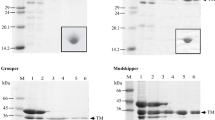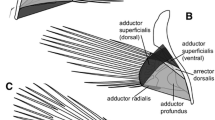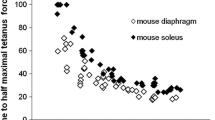Summary
Common carp (Cyprinus carpio L.) were acclimated to either 2, 5, 8, 11, 15, 20, or 23°C for 12 weeks (12 h light: 12 h dark). Fish did not feed after 6 weeks at temperatures below 8°C. Skinned fibres were prepared from fast myotomal muscle by freeze-drying. Measured at 0°C unloaded contraction velocity (Vmax) and maximum isometric tension generation (Po) were 2–3 times higher in the 11°C-than 23°C-acclimated groups, and had intermediate values in 15 °C-acclimated fish. Po and Vmax at 0°C were not significantly different for carp maintained at 2, 5, 8, or 11°C. Measured at the acclimation temperature of each group Vmax and Po were 51% and 71% lower for fibres from 2°C- than 23°C-acclimated fish. The results indicate a partial capacity adaptation of muscle power output in fish acclimated between 11°C and 23°C. At 8°C the ATPase activity of myofibrils was 2 times higher in fish acclimated to 8°C than to 20°C. The effects of temperature acclimation on the protein composition of myofibrils was investigated using one- and two-dimensional electrophoresis. Peptide maps of purified myosin heavy chains and actin prepared by proteolytic digestion with either Staphylococcus aureus V8 protease or chymotrypsin were similar for both acclimation groups. The molecular weights and isoelectric points of the major isoforms of tropomyosin, troponin C, troponin I, troponin T, and myosin light chains (MLC1, MLC2 and MLC3) were also similar in 8°C- and 20°C-acclimated carp. A 20 kDa molecular weight protein with a pI intermediate between that for MLC2 and MLC3 was found in myofibrils and single fibres from carp acclimated to 8°C but was not present in carp acclimated to 20°C. It is suggested that this band corresponds to a myosin light chain isoform unique to cold-acclimated fish. Evidence was also obtained that myofibrils from warm-acclimated fish contained a second minor isoform of troponin I.
Similar content being viewed by others
References
Allington WB, Cordry AL, McCullough GA, Mitchell DE, Nelson JW (1978) Electrophoretic concentration of macromolecules. Anal Biochem 85:188–196
Carraro U, Catani C, Dalla Libera L (1981) Myosin light and heavy chains in rat gastrocnemius and diaphragm muscles after chronic denervation or reinnervation. Exper Neurol 72:401–412
Cleveland DW, Fischer SG, Kirschner NW, Laemmli UK (1977) Peptide mapping by limited proteolysis in sodium dodecyl sulphate and analysis by gel electrophoresis. J Biol Chem 252:1102–1106
Dabrowska R, Szpacenko A (1977) Comparison of the composition and properties of natural actomyosin from carp (Cyprinus carpio) and rabbit skeletal muscle. Comp Biochem Physiol 56B:139–142
Focant B, Jacob MF, Huriaux F (1981) Electrophoretic comparison of the proteins of some perch (Perca fluviatilis L.) head muscles. J Muscle Res Cell Motility 2:295–305
Greaser ML, Moss RL, Reiser PJ (1988) Variations in contractile properties of rabbit single muscle fibres in relation to troponin T isoforms and myosin light chains. J Physiol 406:85–98
Hansen JN (1976) Electrophoresis of ribonucleic acid on a polyacrylamide gel which contains disulphide cross-linkages. Anal Biochem 76:37–44
Hazel JR, Prosser CL (1974) Molecular mechanisms of temperature compensation in poikilotherms. Physiol Rev 54:620–677
Heap SP, Goldspink G (1986) Alterations to the swimming performance of carp, Cyprinus carpio, as a result of temperature acclimation. J Fish Biol 29:747–753
Heap SP, Watt PW, Goldspink G (1985) Consequences of thermal change on the myofibrillar ATPase of 5 freshwater teleosts. J Fish Biol 26:733–738
Heap SP, Watt PW, Goldspink G (1986) Myofibrillar ATPase activity in the carp Cyprinus carpio: interactions between starvation and environmental temperature. J Exp Biol 123:373–382
Heap SP, Watt PW, Goldspink G (1987) Contractile properties of goldfish fin muscles following temperature acclimation. J Comp Physiol B 157:219–225
Hoh JFY, McGrath PA, White RI (1976) Electrophoretic analysis of multiple forms of myosin in fast-twitch and slow-twitch muscles of the chick. Biochem J 157:87–95
Huriaux F, Focant B (1974) Etude comparative, par électrophorèse en gel de polyacrylamide, des myofibrilles des muscles blanc, cardiaque et rouges de carpe. Archs int Physiol Biochem 82:991–992
Huriaux F, Focant B (1978) Effects of some factors on the molecular weight determination of a light chain (LC3) of carp (Cyprinus carpio L.) myosin by SDS polyacrylamide gel electrophoresis. Comp Biochem Physiol 61:195–198
Huriaux F, Focant B (1985) Electrophoretic and immunological study of myosin light chains from freshwater teleost fishes. Comp Biochem Physiol 82B:737–743
Johnston IA (1979) Calcium regulatory proteins and temperature acclimation of actomyosin from a eurythermal teleost, Carassius carassius. J Comp Physiol 129:163–167
Johnston IA, Lucking M (1978) Temperature induced variation in the distribution of different types of muscle fibre in the goldfish (Carassius carassius). J Comp Physiol 124:111–116
Johnston IA, Maitland B (1980) Temperature acclimation in crucian carp (Carassius carassius L.): morphometric analysis of muscle fibre ultrastructure. J Fish Biol 17:113–125
Johnston IA, Gleeson TT (1987) Effects of temperature on contractile properties of skinned muscle fibres from three toad species. Am J Physiol 252:R371–375
Johnston IA, Dunn J (1987) Temperature acclimation and metabolism in ectotherms with particular reference to teleost fish. In: Bowler K, Fuller BJ (eds) Temperature and animal cells. Soc Exp Biol Symp XXXXI:67–93
Johnston IA, Davison W, Goldspink G (1975) Adaptations in Mg2+-activated myofibrillar ATPase activity induced by temperature acclimation. FEBS Lett 50:293–295
Johnston IA, Sidell BD, Driedzic W (1985) Force-velocity characteristics and metabolism of carp muscle fibres following temperature acclimation. J Exp Biol 119:239–250
Jones DR, Sidell BD (1982) Metabolic responses of striped bass (Morone saxatilis) to temperature acclimation. J Exp Zool 219:163–171
Laemmli UK (1970) Cleavage of structural proteins during the assembly of the head of bacteriophage T4. Nature 227:680–685
Lännergren J (1987) Contractile properties and myosin isoenzymes of various kinds of Xenopus twitch muscle fibres. J Muscle Res Cell Motility 8:260–273
Lemons DE, Crawshaw LI (1985) Behavioural and metabolic adjustments to low temperatures in the largemouth bass (Micropterus salmoides). Physiol Zool 58:175–180
Maddy AH, Spooner RO (1970) The erythrocyte agglutinability I. Variation in the membrane protein. Vox Sang 18:34–41
Nabeshima Y, Fujii-kuriyama Y, Muramatsu M, Ogata K (1984) Alternative transcription and two modes of splicing result in two myosin light chains from one gene. Nature 308:333–338
Nicol JCM (1985) A microcomputer program to determine the composition of solutions containing multiple metal ions and complexing ligands. J Physiol 367:10P
O'Farrell PH (1975) High resolution two-dimensional electrophoresis of proteins. J Biol Chem 250:4007–4021
Penney RK, Goldspink G (1979) Compensation limits of fish muscle myofibrillar ATPase to environmental temperature. J Therm Biol 4:269–272
Radola BJ (1980) Ultrathin-layer isoelectric focusing in 50–100 μm polyacrylamide gels on silanized glass plates or polyester films. Electrophoresis 1:43–54
Reiser PJ, Moss RL, Giulan GG, Greaser ML (1985) Shortening velocity in single fibres from adult rabbit soleus muscles is correlated with myosin heavy chain composition. J Biol Chem 260:9077–9080
Rome LC, Loughna PT, Goldspink G (1984) Muscle fibre activity in carp as a function of swimming speed and temperature. Am J Physiol 247:R272–279
Rome LC, Loughna PT, Goldspink G (1985) Temperature acclimation: improved sustained swimming performance in carp at low temperature. Science 228:194–196
Scapolo PA, Rowlerson A (1987) Pink lateral muscle in the carp (Cyprinus carpio L.): histochemical properties and myosin composition. Experientia 43:384–386
Schachat FH, Bronson DD, McDonald DB (1985) Heterogeneity of contractile proteins. J Biol Chem 260:1108–1113
Sender PM (1971) Muscle fibrils: Solubilization and gel electrophoresis. FEBS Lett 17:106–110
Sidell BD (1980) Response of goldfish (Carassius auratus L.) to acclimation temperature: alterations in biochemistry and proportions of different fibre types. Physiol Zool 53:98–107
Stienen GJM, Guth K, Ruegg JC (1983) Force and force transients in skeletal muscle fibres of the frog skinned by freeze-drying. Pflügers Arch 397:272–276
Sweeney HL, Kushmerick MJ, Mabuchi K, Gergely J, Streter FA (1986) Velocity of shortening and myosin isozymes in two types of rabbit fast-twitch muscle fibres. Am J Physiol 251:C431–C434
Syska H, Perry SV, Trayer IP (1874) A new method of preparation of troponin I (inhibitory protein) using affinity chromatography. Evidence for three different forms of troponin I in skeletal muscle. FEBS Lett 40:253–257
Tyler S, Sidell BD (1984) Changes in mitochondrial distribution and diffusion distances in muscle of goldfish (Carassius auratus) upon acclimation to warm and cold temperatures. J Exp Zool 232:1–10
Walsh PJ, Moon T (1982) The influence of temperature on extracellular and intracellular pH in the American eel, Anguilla rostrata (Le Sueur). Respir Physiol 50:129–140
Walsh PJ, Foster GD, Moon T (1983) The effects of temperature on metabolism of the American eel Anguilla rostrata (Le Sueur): Compensation in the summer and torpor in the winter. Physiol Zool 56:532–540
Whalen RG (1985) Myosin isoenzymes as molecular markers for muscle physiology. J Exp Biol 115:43–53
Author information
Authors and Affiliations
Rights and permissions
About this article
Cite this article
Crockford, T., Johnston, I.A. Temperature acclimation and the expression of contractile protein isoforms in the skeletal muscles of the common carp (Cyprinus carpio L.). J Comp Physiol B 160, 23–30 (1990). https://doi.org/10.1007/BF00258759
Accepted:
Issue Date:
DOI: https://doi.org/10.1007/BF00258759




